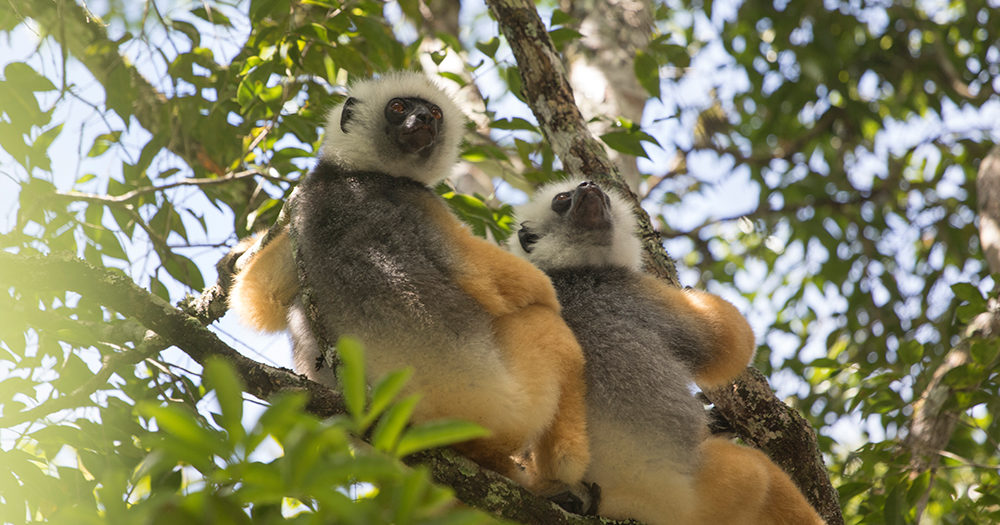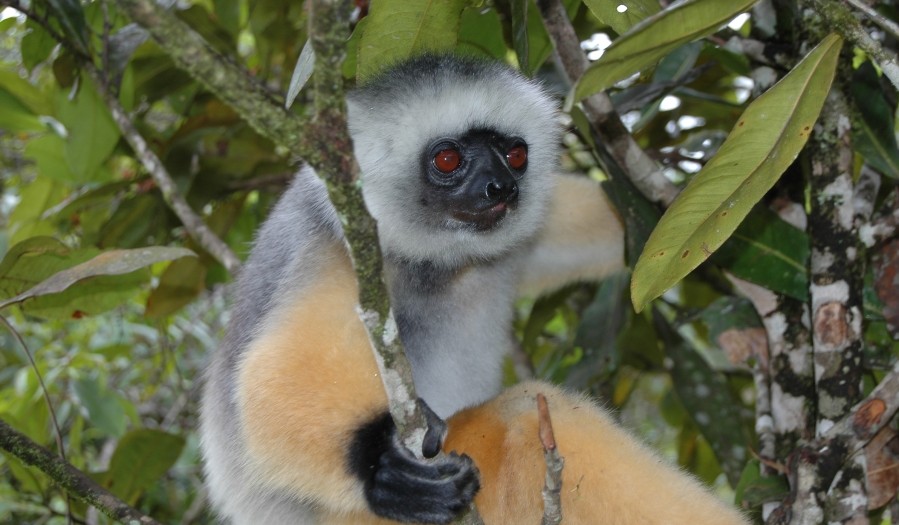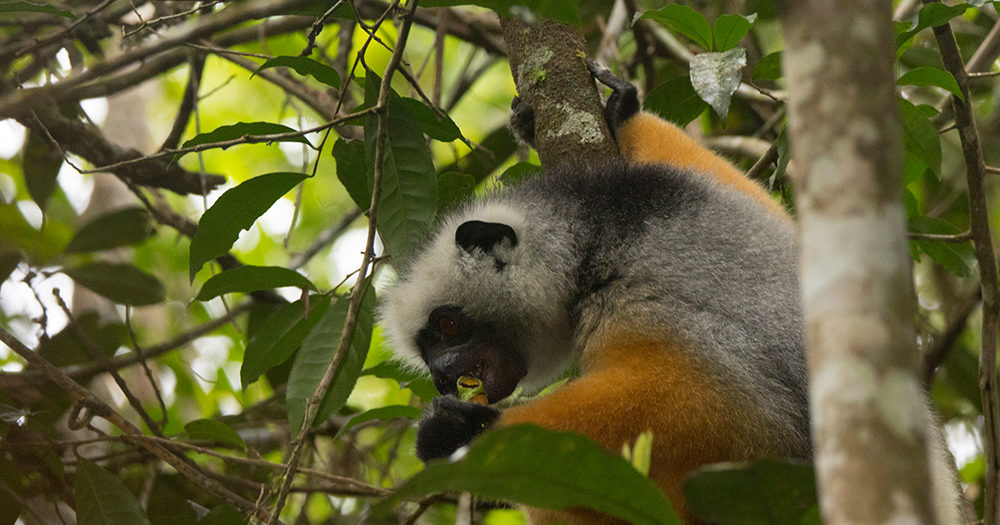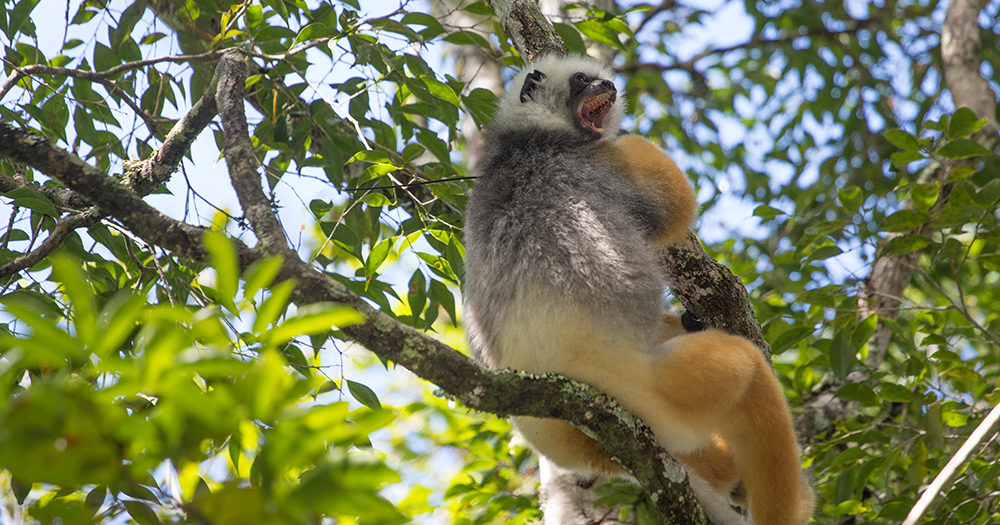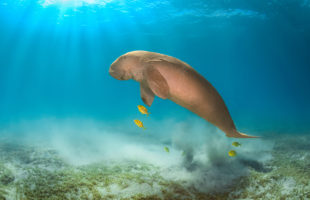The Diademed Sifaka (Propithecus diadema) is with a total length of 105 cm and a weight between five and seven kilograms one of the largest lemurs of Madagascar and because of its unusual fur colors also one of the most beautiful. His face is framed by long white fur, which looks a bit like a tiara and gave these lemurs their species name. The face, hands and feet are hairless and black. The eyes are deep reddish brown. On the head and along the neck, Diademsifaka’s black fur merges into a silver-grey on the shoulders, chest and back. The limbs and the base of the tail are golden yellow.
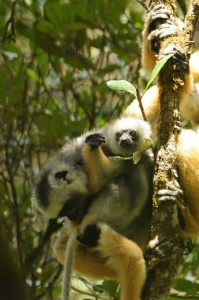
Diademed Sifaka have the largest distribution area of the Sifakas within East Madagascar, whereby also this is not exactly gigantic. It is bordered to the north by the Mananara River and to the south by the Onive and Mongoro Rivers. In between are the national parks Andasibe-Mantadia, Mananara North, Zahamena and the Reserves Ambatovaky, Mangerivola, Maromizaha, Anjozorobe-Angavo and Marotandrano. Many areas where Diademed Sifakas occur are not protected, such as the regions around Anosibe an’ala, Didy, Iofa and Sandranantitra. The forest of Tsinjoarivo has been proposed as a protected area, but has not yet been officially placed under protection. Diademed Sifakas occur regularly at altitudes between 200 and 800 m in the lowland rainforests, in some rainforests they even reach up to 1550 m altitude difference.
Diademed Sifakas live together in groups of two to ten animals of mixed sexes. Each group lives in a territory of 0.2 to 0.8 km² and defends it quite aggressively against other Diademed Sifakas – other lemurs in the same area are tolerated. Diademed Sifakas cover the longest daily distance in search of food and resting places in the trees, averaging about one and a half kilometres a day. They rarely get to the ground. They are very social animals that play, communicate and use rest periods for mutual grooming. Diademed Sifakas feed on more than 25 different plants daily, including seeds, fruits, flowers and leaves. But they just overslept a good half of the day.
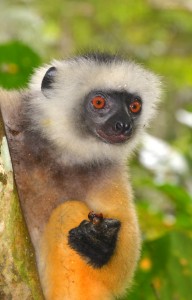
Young Diademed Sifakas are sexually mature at the age of two to three. It is believed that females are only receptive once a year for a few days, perhaps only one in December. The females bear only one young each between May and July, which they take care of for almost two years. In the first year, the offspring clings to the mother’s belly, then it changes to her back. With well five years, the adult males leave their group and join other Diademed Sifakas. This species can probably live to be 20 years old.
Similar to other Sifakas, the males of the Diademed Sifakas have chest glands, which cause a large brown spot on the breast. They mark their territory with it, and males mark about twice as often as females. In the Diademed Sifakas’ habitat, the most dangerous predators are the Fossa, large birds of prey and the Nile crocodile. To protect themselves from these attackers, Diademed Sifakas have different warning shouts: a “tzisk-tzisk-tzisk”, similar to a kissing sound, warns of enemies on the ground, a “honk-honk-honk” of potential sources of danger in the air.
In contrast to many other Sifaka species, the population of Diademed Sifakas with 6000 to 10,000 animals is still relatively stable. Nevertheless, because of its dwindling habitat, the species has been on the IUCN red list for years as critically endangered. The biggest threat is slash-and-burn to gain land for rice and cassava fields, which also do not stop at national park borders, as well as the logging of tropical timber. Besides, these lemurs are not fady (taboo) for the Madagascans, and are hunted because of their flesh. A group of locals killed Diademed Sifakas for high-priced bush meat even inside of protected areas in 2018.
It is estimated that in about 50 years more than 80% of the remaining Diademed Sifaka population will have disappeared.
 MADAMAGAZINE Your Magazine about Madagascar
MADAMAGAZINE Your Magazine about Madagascar
